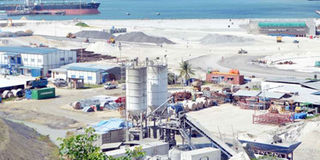China targets Kenya’s ports in trade

An aerial view of Berth 20 at the Port of Mombasa. China is targeting Kenya’s ports of Mombasa and Lamu in expanding its global influence through trade and connectivity. PHOTO | KEVIN OPDIT | NATION MEDIA GROUP
What you need to know:
- Lamu port, whose construction is underway, is part of the larger transportation corridor between Kenya, Ethiopia, South Sudan and Uganda.
- When completed the corridor, also known as LAPSET, will make it easier to ferry crude oil, transport goods and people across these countries.
- The OBOR, also known as the Silk Road Initiative, is the brainchild of President Xi Jingping, to create China-centric networks as a way of expanding its political and economic influence around the world.
China is targeting Kenya’s ports of Mombasa and Lamu in expanding its global influence through trade and connectivity.
The Chinese government lists the two ports as important to its One Belt One Road (OBOR) Initiative, an ambitious programme meant to create “a community of common destiny” from among 63 countries around the world with about 4.5 billion people.
The Port of Mombasa is the busiest in East Africa, serving Kenya, Uganda, Rwanda, South Sudan and the Democratic Republic of Congo.
Lamu port, whose construction is underway, is part of the larger transportation corridor between Kenya, Ethiopia, South Sudan and Uganda.
When completed the corridor, also known as LAPSET, will make it easier to ferry crude oil, transport goods and people across these countries.
“It is an important initiative that we could tap into. But first, we will have to assess it, domesticate it, and hopefully make our people see its value,” Mr Michael Kinyanjui, Kenya’s ambassador to Beijing said of OBOR.
VERY BENEFICIAL
“If it works as planned, it could be very beneficial.” The Chinese believe it will eventually benefit everyone among the group of 63 countries by 2030, even though the initial target is countries in the Far East. “This is a common opportunity for all of us. Trading will be very critical, and we insist on going global while building resources from within,” Mr Qian Keming, Chinese Vice-Minister for Commerce told a conference on the Initiative last week in Beijing.
“We have to talk with our partners to unleash the spirit of competitiveness. We have to consider the benefits as well as the interests of different countries,” he added.
The OBOR, also known as the Silk Road Initiative, is the brainchild of President Xi Jingping, to create China-centric networks as a way of expanding its political and economic influence around the world.
Basically, it is a development plan that banks on cooperation and connectivity of countries. For a start, China planned to invest as much as $900 billion in infrastructure. This money would go to pipelines, roads, railways, airports and sea ports.
But it is also banking on existing infrastructure. Kenya’s two ports, the port in Mogadishu, Djibouti and Dar es Salaam are indicated as important link points in the programme.
It mimics the historic Silk Road and the maritime voyages made by Chinese sailor Zheng He to Mombasa and Malindi during the age of exploration. It seeks to create a business highway on land, sea and air. Gas pipelines, economic corridors, railways, maritime highways running from China’s Quanzhou city (not to be confused with Guangzhou) through Thailand, Indonesia, India, Sri Lanka, and to the Ports on East African coast.
Yet there are challenges to be surmounted. Though launched in 2013, the Initiative has received lukewarm interests from countries initially labelled as important to it.




